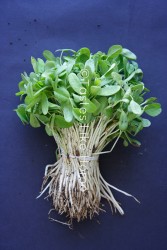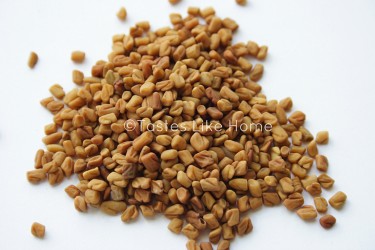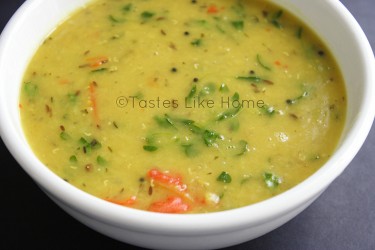Hi Everyone, One of the pleasures of visiting outdoor markets is that there is always something new to discover. It could be a fruit, herb, vegetable or spice. It could be finding out a new way to cook an ingredient or it could be a revelation such as tasting the flavour of a spice as an herb, or vice versa.
Several weeks ago I came upon fresh fenugreek leaves also known as methi. Fenugreek seeds are a spice used in many spice mixes – ground or whole. Many would be familiar with it as part of the spice composition for garam masala and would most likely use the Urdu, Hindi or Punjabi word for it – methi.
 At first glance I thought the bundles were watercress harvested as a microgreen but the lady behind the stall advised me that it was methi. I was pleasantly surprised and my admiration for Bajan small farmers grew more. From experience, and I don’t think that I would be wrong in saying that Bajans do not seem to be the most adventurous people when it comes to eating. But let me tell you, Bajan farmers will often plant and grow vegetables and herbs that are new to the flavour profile of their local cuisine.
At first glance I thought the bundles were watercress harvested as a microgreen but the lady behind the stall advised me that it was methi. I was pleasantly surprised and my admiration for Bajan small farmers grew more. From experience, and I don’t think that I would be wrong in saying that Bajans do not seem to be the most adventurous people when it comes to eating. But let me tell you, Bajan farmers will often plant and grow vegetables and herbs that are new to the flavour profile of their local cuisine.
These small farmers know how to respond to demand – at least in the area of vegetables and herbs. And as the Barbadian population has become increasingly diverse, Bajan farmers have sought to give their customers the flavours of home.
While I was very familiar with methi as a spice, as I use it often in a variety of spice mixes, I had never seen or used the leaves. Over the years, I was aware of the leaves through the food blogs of friends from the subcontinent but like I said, I had never seen the stuff in real life. Harvested as microgreens, the leaves are small and tender, almost clover-like in appearance. They are harvested in bundles with their tender stems and roots still intact. Methi has a pleasant bitter taste but not as pronounced as karaila. I say pleasant because I love the bitterness of karaila. I bought 4 bundles of methi.


Methi leaves can be used very much the same way that spinach/callaloo leaves are used – sautéed on their own or with potatoes, cauliflower, cooked in with rice, added to dhals, stir-fried, chopped and mixed with peas to make fritters, added to salads, to dough to make roti(s) and to curries. Its uses are many. I had already planned to cook dhal that day so when I bought the methi, I decided to make methi dhal.
I’ll get back to the dhal later.
Methi/fenugreek, particularly the seeds have a long history of being widely used all over the world, either as a spice with which to cook or as an herbal medicine. While it is most popularly known as a spice in Indian cuisine, fenugreek is also used in Turkish, Persian, Egyptian, Eritrean and Ethiopian cuisines. According to research, in Ethiopia, the seeds are used as a natural herbal medicine in the treatment of diabetes.
In India it is used in the practice of Ayurvedic medicine to treat a variety of ailments such as arthritis, asthma, bronchitis, diabetes; to improve digestion and even to induce labour.
Today, in many health food stores you can find fenugreek in the form of seeds, powdered seeds, dried leaves, capsules, and as an herbal tea. A quick search on the Internet will yield dozens of sites touting the many health benefits of fenugreek in the practice of alternative medicine. However, according to certified naturopathic doctor, nutritionist and alternative medicine expert, Cathy Wong, though preliminary research – done on animals – is encouraging and suggest that fenugreek may be a helpful remedy in the treatment of diabetes and high cholesterol, we must keep in mind that such effectiveness does not confirm the same in humans. In other words, while tests and research may yield excellent results in the treatment of a variety of ailments in the animals tested, it does not mean that the results will be just as effective in humans. Research is still ongoing.
Here’s the thing, we find ourselves in an age where modern medicine works alongside alternative, traditional and folk medicine. Is one practice better than the other? Does it have to be that way, one better than the other? Each day is a revelation and an opportunity to learn something new.

There are people who will swear that the use of certain herbs, spices and vegetables cure all their ailments. Who is to say they are wrong? My mother swears that the bay leaves, whole cinnamon and nutmeg she uses help with her arthritis. I can’t argue with that – she has lost weight, looks great, is walking a lot more and has less occasions of pain in her knees and hands.
I do believe that certain foods have healing properties. Whatever the benefits of methi – seeds and leaves, I thoroughly enjoyed the flavour and texture they brought to my dhal, and by extension, my meal. The methi leaves wilt very quickly so it is best added towards the end of whatever you are cooking. And just like spinach, it reduces significantly in quantity. I shared some of the dhal with a friend who was a little put off by the slight bitterness.
Of course I welcomed the bitterness; it was subtle. The leaves tasted herby and green, that’s the best way to describe it and then the bitterness came at the end.
Methi seeds have a lot more flavour, there are notes of sweetness, nuttiness and bitterness. As a spice they have preservative properties and you will therefore find them used generously in making certain pickles and chutneys, especially those that do not require cooking but curing at room temperature.
Next week, we’ll talk about cilantro (fresh coriander) – it is another herb that seeds and becomes a spice that is widely used.
Cynthia
www.tasteslikehome.org








